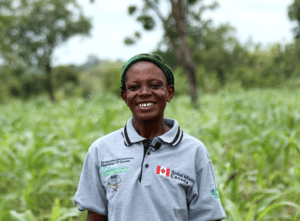When the 4R Nutrient Stewardship project was introduced in the Kpandai district of Northern Ghana, the feeling was somewhat indifferent among the farmers. Men were content cultivating and making good returns from their yam cultivation (predominantly “male “crop), and women too, were happy with their return from groundnut cultivation (predominantly a “female” crop). Through the establishment of the farmer co-operatives in the Kpandai district, the project began to introduce farmers to the 4R demonstration sites that opened their eyes to new possibilities. To effectively demonstrate to farmers the benefits of 4R practices on crop productivity, the 4R solution project established 12 maize and 12 groundnut 4R demonstration sites that serve as learning centers where farmers are trained on best crop and fertilizer management practices through a participatory approach. Farmers were actively involved during key activities such as planting and fertilizer application at these sites. In doing so, farmers saw with their own eyes that the 4R technology was a game changer and could help them attain yields more than they ever knew.

Kpantin Yaba- CVAEA, Katiejeli| Kpandai District
Kpantin Yaba, a 43-year-old woman, a mother of four and now a 4R Solution project Community Volunteer Agricultural Extension Agent (CVAEA) from Katiejeli in the Kpandai district, is one of these farmers who participated in these learning sites. Her passion for community growth and economic improvement motivates her to sometimes walk to farms 4 miles away to assist other farmers in the community to share her knowledge and experience of the 4Rs.
Kpantin cultivates maize on her farmland together with her husband, who is also a member of the co-operative formed under the 4R Solution project. Before the project, they farmed on separate lands. but after they went through the Gender Model Family training through the project’s gender component, Kpantin and her husband, Yaba, now a team and jointly cultivated five- acres of maize in this cropping season.

Kpantin and her husband weeding their maize field
“Before the project, we were working very hard in our fields, but now we know it wasn’t giving the return we could get. We didn’t understand what we were doing. We just planted the seeds in any way and applied fertilizer any time whenever we could afford it. Sometimes we would use one bag of fertilizer for two acres of land” – Kpantin reminisced on their past agronomic practices, which gave poor yield for her household and her community.
On our recent visit to her farm in September, we could see Kpantin had planted the maize in neat rows and applied basal fertilizer by dibbling and burying, awaiting top dressing. She was also weeding her field with her husband Yaba. We asked the couple, out of curiosity, why they went through all trouble of planting a five-acre field with garden lines, applying fertilizer by dibbling and burying. Kpantin quickly interrupted, telling us, “This is only “trouble” for the lazy; anyone who has tasted the benefits of the 4R will never call this “trouble.”
She then says, “Before the 4R project, I used to cultivate a two-acre maize field. I planted randomly and mostly did not apply fertilizer because no one was there to help me. The weeding too was inconsistent as it was also labour-intensive for me alone. When it was time for harvesting, I harvested 3-4 bags of maize from the two-acre field. I was content with it thinking it was probably the soil or the inconsistent rainfall. But after I joined the 4R co-operative and participated in the demonstration plot field days, I applied the lessons from there on my same two- acres of land in 2021 – planted in rows, applied fertilizer two weeks after planting by dibbling and burying, and top dressed at six weeks. At harvesting, guess what? I harvested 10 bags of maize from the same two-acre land! So why won’t I double my acreages with my husband and do the right thing?”
The extra six bags, which she was not used to getting, were sold and used for her children’s school expenses and her other household needs. She added that as a Community Volunteer Agricultural Extension Agent (CVAEA), she goes to the cooperative members’ farms to assist them in following the right farming practices to double their yields. She is eager to share her experiences with other community people to do the right thing so they can all benefit from 4R practices. She also added that so far, she hasn’t received any resistance from co-operative members. Both men and women are receptive to her assistance as they have seen how she and a few others in the community are a testimony to the effects of the 4R practices.
Kpantin Yaba says she and the other CVAEAs vision is to ensure everybody in the community adopts the 4R principles and increases crop yields. “I will never go back to my old practices and continue to be a volunteer in the community even after the project exits.” – says Kpantin.
Northern Ghana is known for its food security issues. Climate change is beginning to frustrate farmers as rain patterns change, and prolonged droughts are causing some farmer fields to perform poorly.
Besides 4R practices, farmers in the project districts are also being introduced to drought-resistant seed varieties that perform better than regular seeds in drought conditions. This could save the farmer from losing all his investments as these seeds can survive the drought period.
Kpanti Yaba and the other CVAEAs are actively learning and participating in this journey to take the lessons and resources to other community members. They are “Leaving NO ONE behind.”